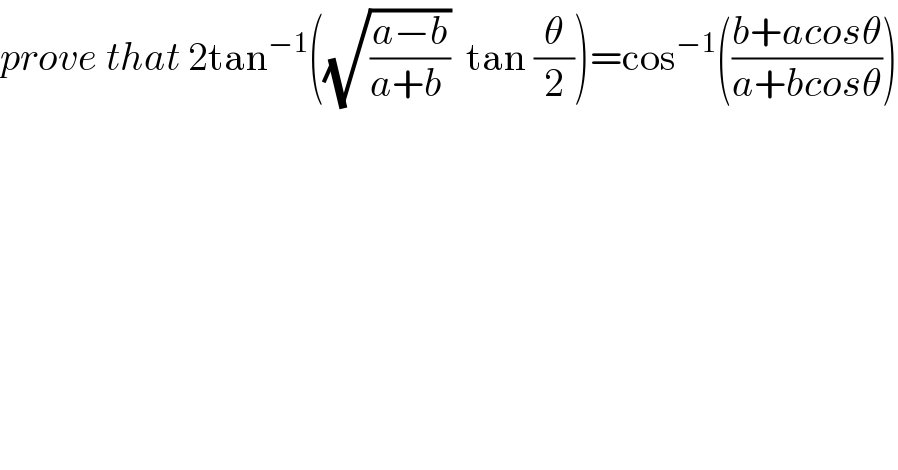
Question Number 44478 by peter frank last updated on 29/Sep/18

$${prove}\:{that}\:\mathrm{2tan}^{−\mathrm{1}} \left(\sqrt{\frac{{a}−{b}}{{a}+{b}\:}}\:\:\mathrm{tan}\:\frac{\theta}{\mathrm{2}}\right)=\mathrm{cos}^{−\mathrm{1}} \left(\frac{{b}+{acos}\theta}{{a}+{bcos}\theta}\right) \\ $$
Answered by tanmay.chaudhury50@gmail.com last updated on 29/Sep/18
![RHS cos^(−1) (((b+a((1−t^2 )/(1+t^2 )))/(a+b((1−t^2 )/(1+t^2 ))))) [where t=tan(θ/2)] cos^(−1) (((b+bt^2 +a−at^2 )/(a+at^2 +b−bt^2 )))=α (say) cosα=(((a+b+bt^2 −at^2 )/(a+b+at^2 −bt^2 ))) (1/(cosα))=((a+b+at^2 −bt^2 )/(a+b+bt^2 −at^2 )) ((1−cosα)/(1+cosα))=((a+b+at^2 −bt^2 −a−b−bt^2 +at^2 )/(a+b+at^2 −bt^2 +a+b+bt^2 −at^2 )) tan^2 (α/2)=((2(a−b)t^2 )/(2(a+b))) tan(α/2)=(√((a−b)/(a+b))) ×t tan(α/2)=(√((a−b)/(a+b))) tan(θ/2) (α/2)=tan^(−1) ((√(((a−b)/(a+b)).)) tan(θ/2) α=2tan^− ((√((a−b)/(a+b))) tan(θ/2)) so LHS=RHS](Q44484.png)
$${RHS} \\ $$$${cos}^{−\mathrm{1}} \left(\frac{{b}+{a}\frac{\mathrm{1}−{t}^{\mathrm{2}} }{\mathrm{1}+{t}^{\mathrm{2}} }}{{a}+{b}\frac{\mathrm{1}−{t}^{\mathrm{2}} }{\mathrm{1}+{t}^{\mathrm{2}} }}\right)\:\:\:\:\:\left[{where}\:{t}={tan}\frac{\theta}{\mathrm{2}}\right] \\ $$$${cos}^{−\mathrm{1}} \left(\frac{{b}+{bt}^{\mathrm{2}} +{a}−{at}^{\mathrm{2}} }{{a}+{at}^{\mathrm{2}} +{b}−{bt}^{\mathrm{2}} }\right)=\alpha\:\:\left({say}\right) \\ $$$${cos}\alpha=\left(\frac{{a}+{b}+{bt}^{\mathrm{2}} −{at}^{\mathrm{2}} }{{a}+{b}+{at}^{\mathrm{2}} −{bt}^{\mathrm{2}} }\right) \\ $$$$\frac{\mathrm{1}}{{cos}\alpha}=\frac{{a}+{b}+{at}^{\mathrm{2}} −{bt}^{\mathrm{2}} }{{a}+{b}+{bt}^{\mathrm{2}} −{at}^{\mathrm{2}} } \\ $$$$\frac{\mathrm{1}−{cos}\alpha}{\mathrm{1}+{cos}\alpha}=\frac{{a}+{b}+{at}^{\mathrm{2}} −{bt}^{\mathrm{2}} −{a}−{b}−{bt}^{\mathrm{2}} +{at}^{\mathrm{2}} }{{a}+{b}+{at}^{\mathrm{2}} −{bt}^{\mathrm{2}} +{a}+{b}+{bt}^{\mathrm{2}} −{at}^{\mathrm{2}} } \\ $$$${tan}^{\mathrm{2}} \frac{\alpha}{\mathrm{2}}=\frac{\mathrm{2}\left({a}−{b}\right){t}^{\mathrm{2}} }{\mathrm{2}\left({a}+{b}\right)} \\ $$$${tan}\frac{\alpha}{\mathrm{2}}=\sqrt{\frac{{a}−{b}}{{a}+{b}}}\:×{t} \\ $$$${tan}\frac{\alpha}{\mathrm{2}}=\sqrt{\frac{{a}−{b}}{{a}+{b}}}\:{tan}\frac{\theta}{\mathrm{2}} \\ $$$$\frac{\alpha}{\mathrm{2}}={tan}^{−\mathrm{1}} \left(\sqrt{\frac{{a}−{b}}{{a}+{b}}.}\:{tan}\frac{\theta}{\mathrm{2}}\right. \\ $$$$\alpha=\mathrm{2}{tan}^{−} \left(\sqrt{\frac{{a}−{b}}{{a}+{b}}}\:{tan}\frac{\theta}{\mathrm{2}}\right) \\ $$$${so}\:{LHS}={RHS} \\ $$
